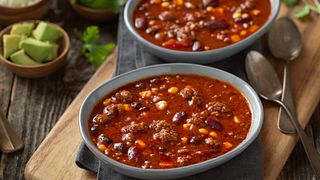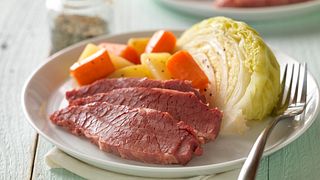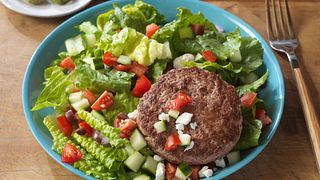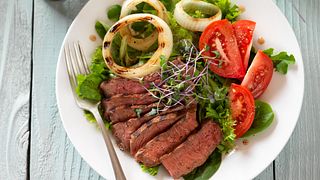Beef and Health
Beef has an abundance of nutrients like B-vitamins, zinc, iron and protein and comes in such a delicious package with relatively few calories. Among the many delicious benefits you get from enjoying lean beef, one of the most remarkable is its role in supporting health. Read more about beef and health.
Heart Health Benefits of Lean Beef
Studies show that eating lean beef, as part of a balanced diet, supports healthy blood pressure and blood lipids.1-3 A diet lower in sodium and higher in potassium and lean protein helps lower blood pressure.4 Beef is a leading source of potassium in the U.S. diet and is estimated to contribute only 1% of sodium intake.5,6 Research also shows that partially replacing carbohydrates in the diet with protein could be a useful strategy for the prevention of hypertension and cardiovascular disease.7
Despite misconceptions to the contrary, beef contributes 10 percent or less of saturated fat and total fat in the American diet.6 Approximately one-third of beef’s saturated fat is stearic acid, the same fat recognized as beneficial in chocolate for its neutral effect on blood cholesterol levels.8-11 Beef is also a primary source of monounsaturated fat in the diet, the same type of healthy fat found in avocados and olive oil.8,12 With this in mind, it isn’t surprising that a number of clinical studies consistently demonstrate that consuming 4-5.5 ounces of lean beef as part of a heart-healthy diet, even daily, can contribute to overall healthful dietary patterns and improved markers for health.1-3,13
Beef in an Optimal Lean Diet study: American Journal of Clinical Nutrition journal article
Diet and Cancer
Reducing cancer risk requires a total lifestyle approach, which includes eating a balanced diet, being physically active and maintaining a healthy weight. It is difficult to study the diet and its effects on cancer because humans consume many food components in their total diet that may both protect against and increase their risk of cancer.14-16 Observational studies suggest that dietary components may be associated, but not responsible for increasing cancer risk, and this association could differ between subjects with and without cancer. Although clinical trials are necessary to test whether there is a causal effect between a specific food component and increase or decrease in cancer risk, for ethical reasons, these studies are generally not conducted.14
Emphasizing or eliminating any one food or nutrient does not eliminate one’s risk for disease, and doing so could lead to unintended consequences, such as nutrient gaps. Americans are, on average, currently consuming red and processed meat within the amounts recommended by the Dietary Guidelines for Americans, therefore, for most people, balance needs to come from swapping refined grains and empty calories for whole grains and vegetables.17-18 Beef contains high-quality protein, iron and zinc which strengthen a balanced diet and are a perfect complement to the nutrients found in plant foods.6,8
Easy Ways to Make Beef Part of an Overall Healthy Diet:
- Choose lean beef. Today’s beef is leaner than ever, with a wide selection of cuts that meet the government definition of “lean.” Look for 95% lean Ground Beef, choose loin or round cuts, and consider steaks such as T-Bone, Sirloin, and Flank Steak.
- Don’t forget the fruits and veggies. Beef pairs perfectly with fruits and vegetables like zucchini, corn, pineapple and plums that add delicious flavor to a nutrient-rich meal with beef.
- When preparing a meal, include flavor-rich vegetable toppings, such as mushrooms and peppers.
- When dining out, order child-sized burgers or eat half a steak for dinner and save the rest for lunch the next day.
- When cooking beef, use medium heat. High heat can overcook or char the outside of beef cuts while the interior remains underdone. Charring is not recommended.
- When cooking beef, use medium heat. High heat can overcook or char the outside of beef cuts while the interior remains underdone. Charring is not recommended.
- Marinades with little or no sugar may help protect meat from charring and also have been shown to reduce formation of compounds called heterocyclic aromatic amines.
For more inspiration and ideas, check out our collection of heart-healthy recipes.
Resources for Health Professionals
- Beef in an Optimal Lean Diet study: American Journal of Clinical Nutrition journal article
- Roussell MA, et al. Beef in an Optimal Lean Diet study: effects on lipids, lipoproteins, and apolipoproteins. Am J Clin Nutr 2012;95:9-16.
- Roussell MA, et al. Effects of a DASH-like diet containing lean beef on vascular health. J Hum Hypertens2014;28:600-5.
- Maki KC, et al. A meta-analysis of randomized controlled trials that compare the lipid effects of beef versus poultry and/or fish consumption. J Clin Lipidol 2012;6:352-61.
- Perez V, Chang ET. Sodium-to-potassium ratio and blood pressure, hypertension, and related factors. Adv Nutr 2014;5:712–41.
- O’Neil C, et al. Food sources of energy and nutrients among adults in the US: NHANES 2003-2006. Nutrients 2012; 4:2097-120.
- Zanovec M, et al. Lean beef contributes significant amounts of key nutrients to the diets of US adults: National Health and Nutrition Examination Survey 1999-2004. Nutr Res 2010;30:375-81.
- Rebholz CM, et al. Dietary protein intake and blood pressure: a meta-analysis of randomized controlled trials. Am J Epidemiol 2012;176:S27-43.
- U.S. Department of Agriculture, Agricultural Research Service, Nutrient Data Laboratory. USDA National Nutrient Database for Standard Reference, Release 28 (Slightly revised). Version Current: May 2016. Available at http://www.ars.usda.gov/ba/bhnrc/ndl
- Denke MA. Role of beef and beef tallow, an enriched source of stearic acid, in a cholesterol-lowering diet. Am J Clin Nutr 1994;60:1044S-9S.
- Kris-Etherton PM, Mustad VA. Chocolate feeding studies: a novel approach for evaluating the plasma lipid effects of stearic acid. Am J Clin Nutr 1994;60:1029S-36S.
- Hunter JE, et al. Cardiovascular disease risk of dietary stearic acid compared with trans, other saturated, and unsaturated fatty acids: a systematic review. Am J Clin Nutr 2010;91:46-63.
- Hammad S, et al. Current evidence supporting the link between dietary fatty acids and cardiovascular disease. Lipids 2016;51:507-17.
- Sayer RD, et al. Equivalent reductions in body weight during the Beef WISE Study: beef's role in weight improvement, satisfaction and energy. Obes Sci Pract 2017;3:298–310.
- National Institutes of Health. National Cancer Institute. Diet. Available at https://www.cancer.gov/about-cancer/causes-prevention/risk/diet.
- Boyle P, et al. Diet, nutrition and cancer: public media and scientific confusion. Ann Oncol 2008; 19: 1665-7.
- Schoenfeld JD, Ioannidis JP. Is everything we eat associated with cancer? A systematic cookbook review. Am J Clin Nutr 2013;97:127-34.
- U.S. Department of Health and Human Services and U.S. Department of Agriculture. 2015–2020 Dietary Guidelines for Americans. 8th Edition. December 2015. Available at http://health.gov/dietaryguidelines/2015/guidelines/
- What We Eat in America, NHANES 2009-2010 (WWEIA FPED 2009-2010), individuals 2 years and over (excluding breast-fed children), day 1 dietary intake data, weighted. Food Patterns Equivalents Database (FPED) 2009-2010.







